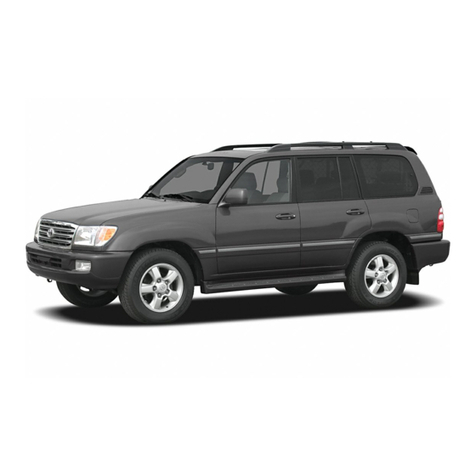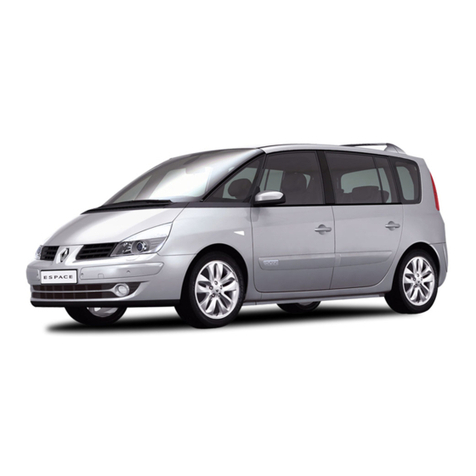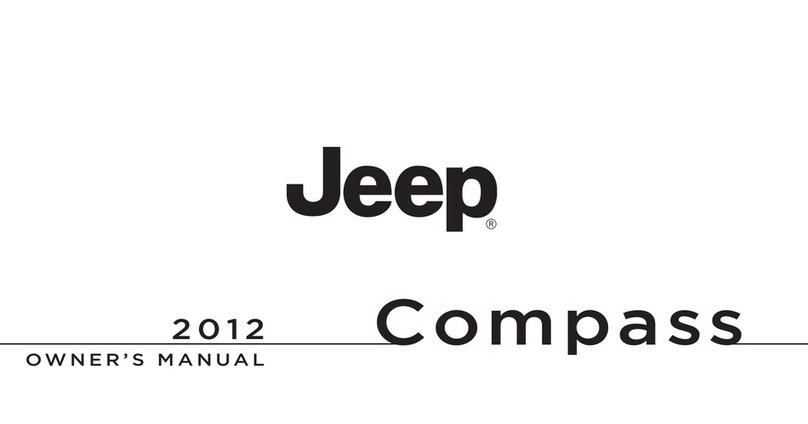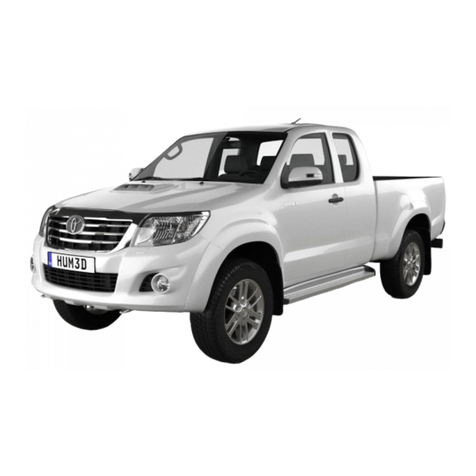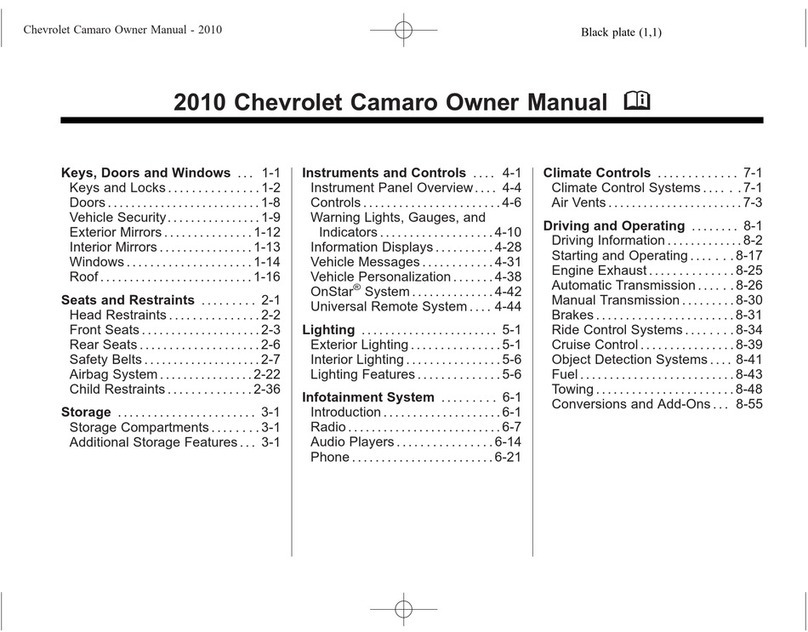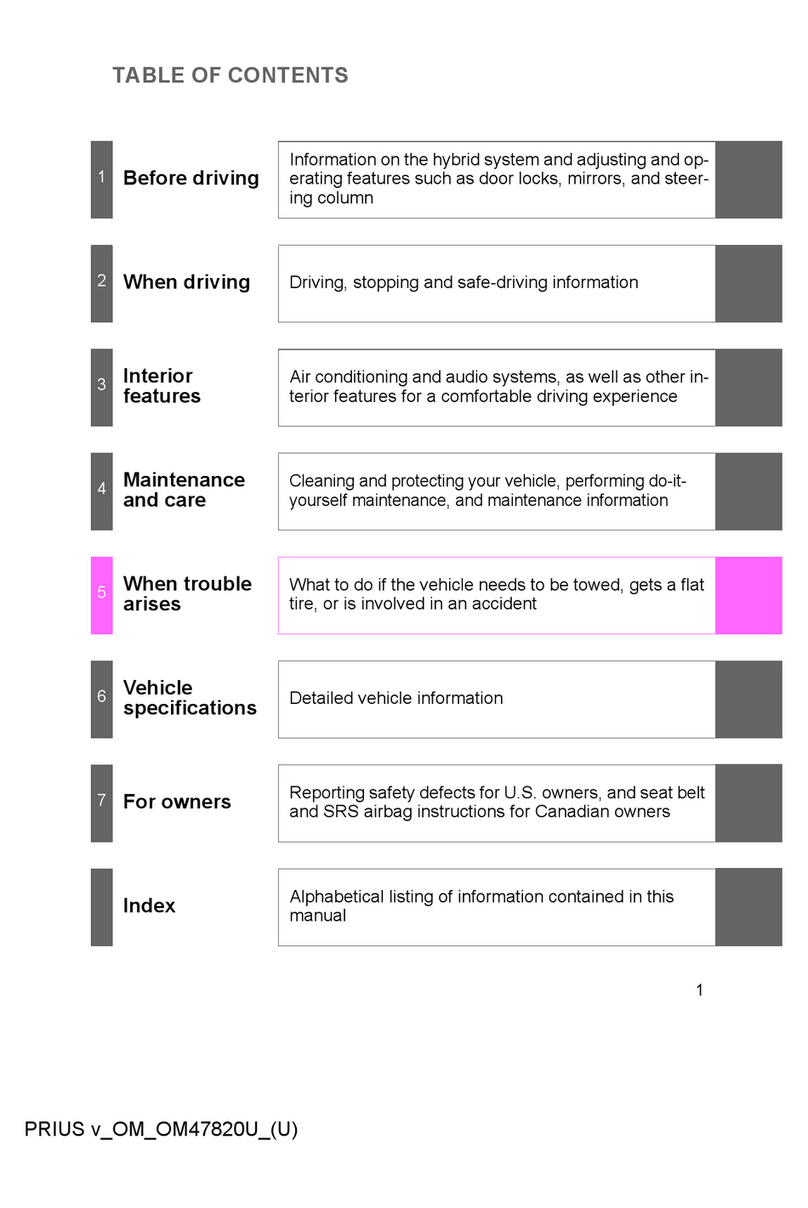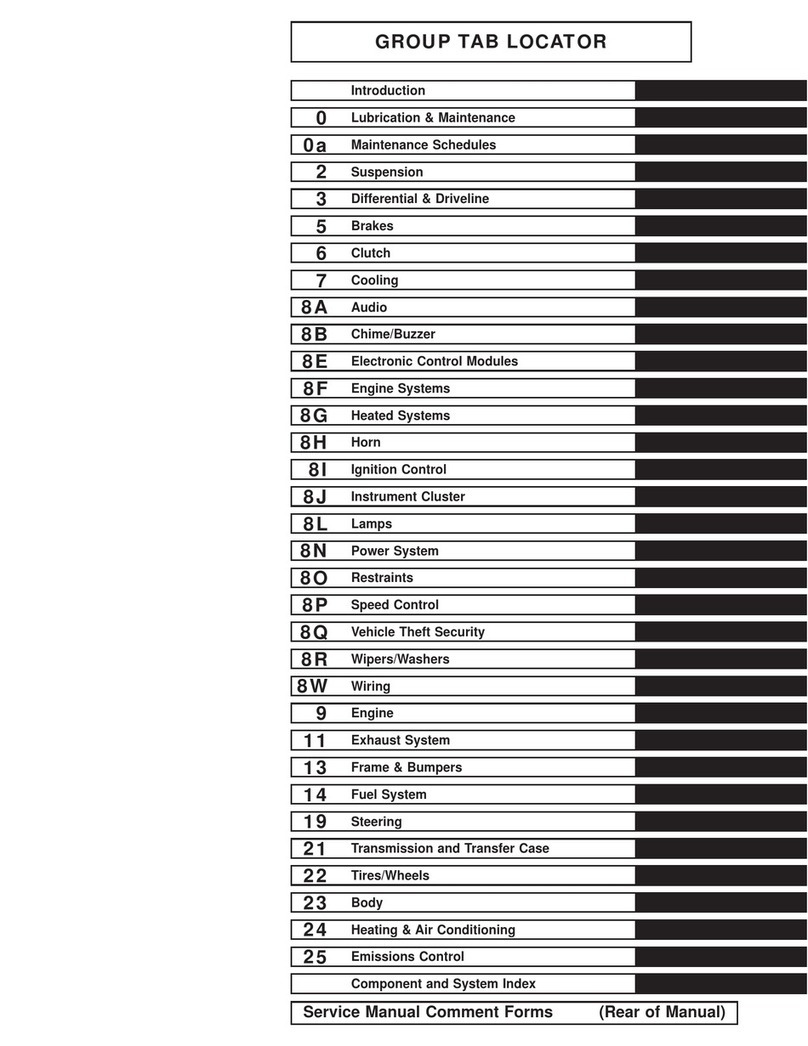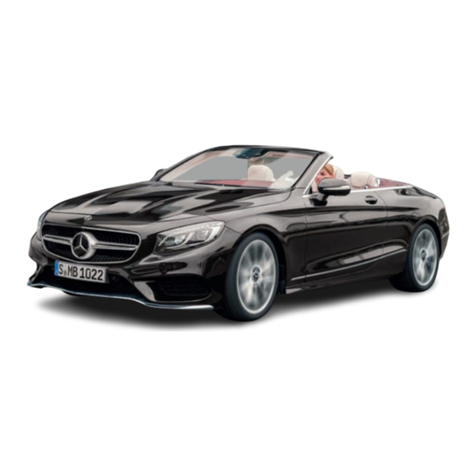Chana M201 2014 Instruction manual



M201 2014.01
2014 M201
Workshop Manual
Table of Contents
1.1 Service Information
1.1.1 Overview .......................................1.1.1-1
1.1.2 Identification Codes ......................1.1.2-1
1.1.3 Traction and Lifting........................1.1.3-1
1.1.4 Maintenance Interval.....................1.1.4-1
1.1.5 Noise, Vibration and Harshness....1.1.5-1
2.1 Suspension System
2.1.1 Suspension System - Overview ....2.1.1-1
2.1.2 Front Suspension..........................2.1.2-1
2.1.3 Rear Suspension ..........................2.1.3-1
2.1.4 Wheel and Tire..............................2.1.4-1
2.2 Drive System
2.2.1 Driveline System - Overview.........2.2.1-1
2.2.2 Propeller Shaft ..............................2.2.2-1
2.2.3 Drive Shaft ....................................2.2.3-1
2.2.4 Differential .....................................2.2.4-1
2.3 Brake System
2.3.1 Brake System - Overview..............2.3.1-1
2.3.2 Rear Drum Brake ..........................2.3.2-1
2.3.3 Front Disc Brake ...........................2.3.3-1
2.3.4 Parking Brake and Operation........2.3.4-1
2.3.5 Hydraulic Brake Control ................2.3.5-1
2.3.6 Power Brake .................................2.3.6-1
2.4 Steering System
2.4.1 Steering System - Overview ......... 2.4.1-1
2.4.2 Steering Gear................................ 2.4.2-1
2.4.3 Steering Column ........................... 2.4.3-1
3.1 Engine
3.1.1 Engine System - Overview ........... 3.1.1-1
3.1.2 Mechanical System....................... 3.1.2-1
3.1.3 Lubrication System ....................... 3.1.3-1
3.1.4 Cooling System............................. 3.1.4-1
3.1.5 Air Intake System.......................... 3.1.5-1
3.1.6 Exhaust System............................ 3.1.6-1
3.1.7 Fuel System.................................. 3.1.7-1
3.1.8 Ignition System ............................. 3.1.8-1
3.1.9 Starting System............................. 3.1.9-1
3.1.10 Charging System ...................... 3.1.10-1
3.1.11 Emission Control System.......... 3.1.11-1
3.1.12 Electronic Control
System - M7.............................. 3.1.12-1
3.2 Manual Transmission/Clutch
3.2.1 Manual Transmission/
Clutch - Overview ......................... 3.2.1-1
3.2.2 Clutch..........................................3.2.2-1
3.2.3 Manual Transmission ..................3.2.3-1
3.2.4 Manual Transmission External
Control .......................................... 3.2.4-1
GROUP 1 Overview
GROUP 2 Chassis
GROUP 3 Powertrain

M201 2014.01
4.1 Heating, Ventilation and Air
Conditioning
4.1.1 Heating, Ventilation and
Air Conditioning............................ 4.1.1-1
4.2 Body Electrical
4.2.1 Instrument Panel and
Panel Illumination......................... 4.2.1-1
4.2.2 Instrument Cluster ........................ 4.2.2-1
4.2.3 Horn.............................................. 4.2.3-1
4.2.4 Cigarette Lighter........................... 4.2.4-1
4.2.5 Information and
Entertainment System.................. 4.2.5-1
4.2.6 Lighting System............................ 4.2.6-1
4.2.7 Wiper and Washer........................ 4.2.7-1
4.2.8 Central Door Lock ........................ 4.2.8-1
4.2.9 Power Window ............................. 4.2.9-1
4.2.10 Body Control System................ 4.2.10-1
4.2.11 On-board Network .....................4.2.11-1
5.1 Body and Accessories
5.1.1 Front/Rear Windshield.................. 5.1.1-1
5.1.2 Door.............................................. 5.1.2-1
5.1.3 Seat .............................................. 5.1.3-1
5.1.4 Seat Belt....................................... 5.1.4-1
5.1.5 Rearview Mirror ............................ 5.1.5-1
5.1.6 Instrument Panel and Console..... 5.1.6-1
5.1.7 Bumper......................................... 5.1.7-1
5.1.8 Handles, Locks and Latches ........ 5.1.8-1
5.1.9 Interior Trim Panel
and Ornamentation....................... 5.1.9-1
5.1.10 Exterior Trim............................. 5.1.10-1
5.2 Body Repairs
5.2.1 Body Repairs................................ 5.2.1-1
GROUP 4 Electrical
GROUP 5 Body

M201 2014.01
Overview
1
GROUP
1.1 Service Information
1.1.1 Overview ........................................................................................................................... 1.1.1-1
1.1.2 Identification Codes .......................................................................................................... 1.1.2-1
1.1.3 Traction and Lifting............................................................................................................ 1.1.3-1
1.1.4 Maintenance Interval......................................................................................................... 1.1.4-1
1.1.5 Noise, Vibration and Harshness ....................................................................................... 1.1.5-1
SECTION PAGE


M201 2014.01
Service Information
1.1 Service Information
2014 M201
1.1.1 Overview
Description and Operation ............................................................................................................... 1.1.1-1
About This Manual.................................................................................................................... 1.1.1-1
Health and Safety Precautions ................................................................................................. 1.1.1-2
Standard Workshop Practice .................................................................................................. 1.1.1-12
Solvents, Sealants and Adhesives ......................................................................................... 1.1.1-14
Road/Roller Test ..................................................................................................................... 1.1.1-14
1.1.2 Identification Codes
Description and Operation ............................................................................................................... 1.1.2-1
Vehicle Identification Number ................................................................................................... 1.1.2-1
Nameplate ................................................................................................................................ 1.1.2-2
1.1.3 Traction and Lifting
Description and Operation ............................................................................................................... 1.1.3-1
Traction..................................................................................................................................... 1.1.3-1
Jacking ..................................................................................................................................... 1.1.3-1
Lifting ........................................................................................................................................ 1.1.3-2
1.1.4 Maintenance Interval
Description and Operation ............................................................................................................... 1.1.4-1
Maintenance Items ................................................................................................................... 1.1.4-1
Daily Maintenance Schedule .................................................................................................... 1.1.4-2
1.1.5 Noise, Vibration and Harshness
Description and Operation ............................................................................................................... 1.1.5-1
NVH Meaning in Automotive Engineering ................................................................................ 1.1.5-1
Noise Type in Automotive Engineering..................................................................................... 1.1.5-1
Vibration Process Engineering ................................................................................................. 1.1.5-2
Noise and Vibration on Vehicle................................................................................................. 1.1.5-4
Noise and Vibration Caused By Intake and Exhaust Systems ................................................. 1.1.5-4
Vehicle Body............................................................................................................................. 1.1.5-5
Symptom Diagnosis and Testing...................................................................................................... 1.1.5-6
Inspection and Verification........................................................................................................ 1.1.5-6
Table of Contents Pages

M201 2014.01
1.1.1-1 1.1.1-1Overview
1.1.1 Overview
Description and Operation
About This Manual
Introduction
This manual has been written in a format that is
designed to meet the needs of technicians. This
manual provides general descriptions for
accomplishing service and repair work. Following
them will help assure reliability.
Spare Parts
The parts from Changan Automobile Co., Ltd. are
manufactured according to the original factory
standard. Only the genuine parts from Changan
Automobile Co., Ltd. can be used in repair.
Special Tool
Special tool(s) list provided at the beginning of
each procedure are the special tools required to
carry out the repair. Where possible, illustrations
are provided to assist in identifying the special
tool required. The special tools can be ordered
from Changan Automobile Co., Ltd.
Important Safety Instructions
Appropriate service methods and correct repair
procedures are essential for the safe, reliable
operation on the vehicles as well as the personal
safety.
This manual cannot possibly provide all such
variations and advice or cautions as to each.
Anyone who departs from the instructions
provided in this manual must assure that the
operation methods, tools and components used
neither cause personal injury nor break the
vehicle integrity.
Warnings, Cautions and Notes in This
Manual
As you read through this manual, you will come
across WARNINGS and CAUTIONS.
WARNING: Warnings are used to indicate
that failure to follow a procedure correctly
may result in personal injury.
CAUTION: Cautions are used to indicate
that failure to follow a procedure correctly
may result in damage to the vehicle or
repair tools being used.
Refer to: Notes are used to provide
additional information to
effectively help improve repair
efficiency.
How to Use the Manual
This manual covers the maintenance and repair
service procedures.
This manual is structured into groups and
sections, with specific system sections collected
together under their relevant group. A group
covers a specific portion of the vehicle.
The manual is divided into five groups: Overview,
Chassis, Powertrain, Electrical and Body.
Table of Contents of the manual includes all
sections. Each section has a regular structure:
Specifications, Description and Operation,
General Inspection, Symptom Diagnosis and
Testing, DTC Diagnosis and Testing, Removal
and Installation, Disassembly and Assembly.
All left-hand and right-hand references to the
vehicle are taken from a position sitting in the
driver seat looking forward.
All left-hand and right-hand references to the
engine are taken from a position at the flywheel
looking towards the front camshaft pulley.
Specifications
Specifications mainly describes the material
specifications, component specifications, general
specifications (the contents that can be included
in other specifications) and torque specifications.
The information in the specifications shall use the
metrics except the torque (imperial).

1.1.1-2
M201 2014.01
1.1.1-2Overview
Description and Operation
Description and Operation mainly describes the
system components, functions and principles of
the new systems. The "new systems" refer to the
systems that never used on the previous models
of the manufacturer. The purpose of the brief
introduction is to make the technicians get familiar
with the functions and principles of the systems.
The component location view and components
exploded view are also included in this section.
General Inspection
General Inspection mainly describes the general
inspection steps of the system.
Symptom Diagnosis and Testing
Symptom Diagnosis and Testing section
describes the diagnosis and inspection for the
symptom that cannot be judged from the visual
inspection only, excluding the diagnosis and
inspection using diagnostic tool. The contents
include inspection and verification (visual
inspection chart), symptom chart and symptom
diagnosis procedures.
DTC Diagnosis and Testing
DTC Diagnosis and Testing refers to the
diagnosis and testing for the component or
system using diagnostic tool. It covers engine
control module terminal list, DTC code list, data
flow list, active test list and DTC diagnosis
procedure.
Health and Safety Precautions
Introduction
Many of the procedures associated with vehicle
maintenance and repair involve physical hazards
or other risks to health. This subsection lists,
alphabetically, some of these hazardous
operations and the materials and equipment
associated with them. Precautions necessary to
avoid these hazards are identified.
The list is not exhaustive and all operations and
procedures, and the handling of materials, should
be carried out with health and safety in mind.
Before using any product the Materials Safety
Data Sheet supplied by the manufacturer or
supplier should be consulted.
Acid, Alkali and Metal
• Caustic soda, sulphuric acid.
• Electrolyte and cleaning material.
• Irritable and corrosive substances to skin,
eyes, nose, throat and clothes.
Flammable substance and the substance
able to destroy ordinary protective
clothing.
Avoid splashing such substances to the skin,
eyes and clothes. Wear suitable protective
impervious apron, gloves and goggles. Do not
breathe acid mist. Make sure that the eye wash
bottle, shower and soap are readily available for
splashing accidents.
Place Eye Hazard sign.
Air Conditioning Refrigerant
Refer to: Chemical Materials.
Highly flammable substance - observe No
Smoking policy.
Skin contact may result in frostbite.
Instructions given by the manufacturer must be
followed. Wear suitable protective gloves and
goggles to avoid highlight.
If refrigerant comes into contact with the skin or
eyes, immediately flush the affected areas with
water. Eyes should also be rinsed with an
appropriate irrigation solution and should not be
rubbed. Seek medical assistance if necessary.
Air Conditioning Refrigerant - forbidden items:
• Do not expose the air conditioning
refrigerant in the sunshine or heat it.
• Never put the filling bottle vertically when
filling. The filling opening should be
downward.
• Avoid the frost on the air conditioning
refrigerant bottle.
• Avoid the dropping of air conditioning
refrigerant bottle.
• Do not discharge the air conditioning
refrigerant in the atmosphere in any
circumstance.
• Do not use the mixed refrigerant, such as
Freon R12 and R134a.

M201 2014.01
1.1.1-3 1.1.1-3Overview
Adhesives and Sealants
Refer to: Chemical Materials.
Highly flammable substance - observe No
Smoking policy.
Generally, they should be stored in No Smoking
areas. Cleanliness and tidiness in use should be
observed, for example disposable paper covering
benches; should be dispensed from applicators
where possible; containers, including secondary
containers, should be labeled appropriately.
1. Solvent - based Adhesives/Sealers
Follow manufacturer instructions.
2. Water - based Adhesives/Sealers
Those based on polymer emulsions and
rubber latexes may contain small amounts of
volatile toxic and harmful chemicals. Skin and
eye contact should be avoided and adequate
ventilation provided during use.
3. Hot Melt Adhesives
In the solid state, they are safe. In the molten
state, they may cause burns and health
hazards may arise from the inhalation of toxic
fume.
Use appropriate protective clothing and a
thermostatically controlled heater with a
thermal cut-out and adequate extraction.
4. Resin based Adhesives/Sealers, for example,
Epoxide and Formaldehyde Resin
Mixing should be carried out in well ventilated
areas, as harmful or toxic volatile chemicals
may be released.
Skin will incur dermatitis and inhale toxic or
harmful chemicals if contacting with uncured
resins.
Splashes can damage the eyes. Provide
adequate ventilation and avoid skin and eye
contact.
5. Anaerobic, Cyanoacrylate (super-glues) and
other Acrylic Adhesives
Many are irritant, sensitizing or harmful to the
skin and respiratory tract. Some are eye
irritants. Skin and eye contact should be
avoided and the manufacturers instructions
followed.
Cyanoacrylate adhesives (super - glues)
MUST NOT contact the skin or eyes. If skin or
eye tissue is bonded, cover with a clean moist
pad and SEEK IMMEDIATE MEDICAL
ATTENTION. Do not touch the injured area
with hands. Use in well ventilated areas as
vapor can cause irritation to the nose and
eyes.
6. Isocyanate (Polyurethane) Adhesives /
Sealers
Refer to: Resin-based Adhesives.
Individuals suffering from asthma or
respiratory allergies should not work with or
near these materials as sensitivity reactions
can occur.
Over exposure is irritating to the eyes and
respiratory system. Excessive concentrations
may produce effects on the nervous system
including drowsiness. In extreme cases, loss
of consciousness may result. Long term
exposure to vapor concentrations may result
in adverse health effects.
Prolonged contact with the skin may have a
defeating effect which may lead to skin
irritation and in some cases, dermatitis.
Splashes entering the eye will cause
discomfort and possible damage. Any
spraying should preferably be carried out in
exhaust ventilated booths, removing vapor
and spray droplet from the breathing zone.
Wear appropriate gloves, eye and respiratory
protection.
Antifreeze
Refer to: Inflammables, Solvent.
For example, isopropanol, ethylene glycol and
methanol.
Highly flammable, flammable, combustible.
Used in vehicle coolant systems, screenwash
solutions.
The antifreeze will generate steam when heated.
Avoid inhaling such gas.

1.1.1-4
M201 2014.01
1.1.1-4Overview
The antifreeze or other harmful materials may
enter the human body through the skin. Drinking
the antifreeze accidentally may cause death, so
seek immediate medical assistance.
Do not use any of such substances in the cooling
or industrial water use system related to the food
manufacturing or drinking system.
Electrolyte
Refer to: Acid, Alkali and Metal.
The released gas will cause explosion when
charging the battery. Open fire or spark is
forbidden when charging the battery. Ensure
good ventilation.
Brake Fluid
Refer to: Fire Prevention.
Slight irritability may be caused if the braking fluid
is splashed on skin and eyes. Avoid the braking
fluid touching skin and eyes. Because the steam
pressure is low, the harmful steam cannot be
inhaled at normal temperature.
Braze Welding
Refer to: Welding.
Chemical Materials
Refer to: Legal Aspect.
The chemical materials include solvent, sealer,
adhesive, paint, resin foam, electrolyte,
antifreeze, braking fluid, fuel, oil and grease. Be
careful when using and storing the materials.
They may be noxious, harmful, corrosive, irritable
and inflammable and will generate some harmful
gas and dust.
Long term exposure to the chemical materials
may affect the health to different extents.
1. Chemical Materials - operations to be
performed:
• Read the labels on the dangerous article
container and the corresponding
promotion information and instruction
carefully to obtain the relevant safety
information. The safety and health data
table of the substance can be obtained
from the manufacturer.
• Clean the skin and clothes if being
polluted by the chemical materials.
Replace the severely polluted clothes
and clean them.
• Compile operation instructions, and wear
protective clothes to avoid the substance
polluting skin and eyes and inhaling the
harmful gas, acid mist, dust and smog,
etc. and avoid the combustion and
explosion caused by such substance.
• Wash hands immediately after touching
the substance.
• Keep the working area clean, tidy and no
leakage.
• The chemical materials shall be managed
and stored strictly in accordance with the
national and local regulation.
• Keep the materials away from the
children.
2. Chemical Materials - forbidden operations:
• Do not mix the chemical materials
arbitrarily without following the
manufacturer instructions. Mixing some
chemical materials will generate the
harmful substance; the noxious and
harmful gas will be released or the
explosion may occur.
• Do not spray the chemical materials in
the narrow space with person in the
automobile, especially to spray the
solvent chemicals.
• Do not heat or burn the chemical
materials arbitrarily without following the
manufacturer instruction, because some
chemical materials are combustible, and
some substance will release noxious or
harmful gas when burnt.
• Do not leave the container open, as the
gas emitted from the container may be
toxic to the human body or cause an
explosion. Some gas lighter than air will
accumulate in small sections.
• Do not transport the chemical materials
with containers without label.
• Do not wash hands or clothes with the
chemical materials. The chemical
materials, especially the solvent and fuel,
will make the skin dry, and also irritate the
skin to catch dermatitis, or some noxious

M201 2014.01
1.1.1-5 1.1.1-5Overview
and harmful gas will be absorbed
through the skin.
• Do not store other articles with used
empty tank to store the chemical
materials without special treatment.
• Do not smell the chemical materials. The
gas with sudden high concentration will
cause poisoning or injury.
Clutch Fluid
Refer to: Brake Fluid.
Anti-corrosion Materials
Refer to: Solvent and Fire Prevention.
Highly flammable substance - observe No
Smoking policy.
These materials are miscellaneous and the
manufacturers instructions must be followed.
They may contain solvents, resins or petroleum
products, so skin and eye contact should be
avoided. They should not be sprayed in a
confined space without well ventilation.
Cutting
Refer to: Welding.
Dewaxing
Refer to: Solvent and Fuel (Kerosene).
Dust
Dust may be toxic, harmful and irritant to the skin.
Avoid inhaling the powder chemical material or
other dust. Wear respiratory protection if
ventilation is inadequate.
Fine dusts of combustible materials can present
an explosion hazard. Avoid explosive limits and
fire sources.
Electric Shock
Electric shock can result from the use of faulty
electrical equipment or from the misuse of
equipment in good condition.
Make sure that all electrical equipment is
maintained in good condition and regularly tested.
Faulty equipment should be labeled and
preferably removed from the workstation. Make
sure that wires, cables, plugs and sockets are not
frayed, kinked, cut, cracked or otherwise
damaged. Make sure that the electrical
equipment and wires do not come into contact
with water. Make sure that the electrical
equipment is protected by the correct rated fuse.
Never misuse the electrical equipment and never
use the equipment that is in any way faulty.
Failure to do so could be fatal.
Make sure that the cables of electrical tools do
not get trapped and damaged in a vehicle hoist.
Make sure that the electrical workers are trained
in basic First Aid.
In case of an electric shock:
• Switch off the power supply before
touching the victim.
• If it is impossible to switch off the power
supply, push or drag the victim away from
the power source, using dry non-
conductive material.
• Commence resuscitation if trained to do
so.
• Seek medical assistance.
Engine Oil
Refer to: Lubricants and Grease.
Exhaust Gas
Exhaust gas contains asphyxiating, harmful and
toxic chemicals and particles such as carbon
oxides, nitrogen oxides, aldehydes, lead and
aromatic hydrocarbons. Engine should be run
only under conditions of adequate exhaust
extraction or general ventilation and not in
confined spaces.
Gasoline (Petrol) Engine
There may not be adequate warning of odor or of
irritation before toxic or harmful effects arise.
These may be immediate or delayed.

1.1.1-6
M201 2014.01
1.1.1-6Overview
Noise Insulation Fiber
Refer to: Dust.
Used in noise and sound insulation. The fibrous
nature of surfaces and cut chips can cause skin
irritation. This is usually a physical but not a
chemical effect. Precautions should be taken to
avoid excessive skin contact through careful
organization of work practices and the use of
gloves.
Fire Prevention
Refer to: Welding, Foam and Legal
Aspect.
Many of the materials found on or associated with
the repair of vehicles are highly flammable. Some
give off toxic or harmful fume if burnt. Observe
strict fire safety precautions when storing and
handling flammable substances or solvents,
particularly near electrical equipment or during
welding process. Make sure that there is no fire
hazard present and have a suitable fire
extinguisher available before using welding or
heating equipment.
First Aid
Apart from meeting any legal requirements it is
desirable for someone in the workshop to be
trained in First Aid procedures.
Splashes in the eye should be flushed carefully
with clean water for at least ten minutes.
Soiled skin should be washed with soap and
water. In case of cold burns from alternative fuels,
place affected area in cool to cold water.
Individuals affected by inhalation of gas and fume
should be removed to fresh air immediately. If
effects persist, consult a doctor.
If liquids are swallowed inadvertently, consult a
doctor and give him the information on the
container or label. Do not induce vomiting unless
this action is indicated on the label.
Foams - Polyurethane
Refer to: Fire Prevention.
Used in sound and noise insulation. Cured foams
used in seat and trim cushioning.
Follow manufacturers instructions. Unreacted
components are irritating and may be harmful to
the skin and eyes. Wear gloves and goggles.
Individuals with chronic respiratory diseases,
asthma, bronchial medical problems, or histories
of allergic diseases should not work in or near
uncured materials. Some components, vapor or
spray mist can cause direct irritation, sensitivity
reactions and may be toxic or harmful.
Vapor and spray mist must not be inhaled. These
materials must be applied with adequate
ventilation and respiratory protection. Do not
remove the respirator immediately after spraying;
wait until the vapor/mist has been cleared.
Burning of the uncured components and the
cured foams can generate toxic and harmful
fume. Smoking, naked flames or the use of
electrical equipment during foaming operations
should not be allowed. Any heat cutting of cured
foams or partially cured foams should be
conducted with extraction ventilation.
Refrigerant
Refer to: Air-Conditioning Refrigerant.
Fuel
Refer to: Fire, Solvent and Legal Aspect.
Keep fuel away from skin. Wash with clean water
and soap if stained with fuel.

M201 2014.01
1.1.1-7 1.1.1-7Overview
Gasoline (Petrol)
Highly flammable substance - observe No
Smoking policy.
Swallowing gasoline will stimulate mouth and
throat, and if the gasoline is absorbed by the
stomach, it will cause sleepiness and
unconsciousness. A small quantity of gasoline will
cause death of a child. When the inhaled fluid
reaches the lung, the severe damage will be
caused. Contacting the gasoline for a long time
will make the person skin dry and have the strong
irritability. The gasoline entering eyes will cause
blindness. A great amount of benzene is
contained in the gasoline, which is toxic to
person. The gasoline concentration must be very
low, the over-high concentration will stimulate
eyes, nose and throat and make person vomit,
dizziness and dyspnea, even make person lose
consciousness.
The gasoline shall be transported or used in a
place with air circulation. Operating in confined
spaces is not allowed.
For the cleaning and maintenance of gasoline
storage, there must have special preventive
measures. The gasoline cannot be used as the
cleaning agent and cannot be siphoned with
mouth neither.
Kerosene (Paraffin)
Used also as heating fuel, solvent and cleaning
agent.
Flammable substance - observe No Smoking
policy.
Irritation of the mouth and throat may result from
swallowing. Liquid contact dries the skin and can
cause irritation or dermatitis. Splashes to the eye
may be slightly irritating. In normal circumstances,
the low volatilization does not generate harmful
vapor. Volatilization under high temperature
should be avoided (mist may arise in dewaxing).
Avoid skin and eye contact and make sure there
is adequate ventilation.
High Pressure Gas Cylinder
Refer to: Fire Prevention.
Gases such as oxygen, acetylene, argon and
propane are normally stored in cylinders at
pressures of up to 138 bar (2000 psi). Great care
should be taken in handling these cylinders to
avoid mechanical damage to them or to the valve
gear attached. The contents of each cylinder
should be clearly identified by appropriate
markings.
Cylinders should be stored in well-ventilated
enclosures, and protected from ice and snow, or
direct sunlight. Fuel gas, for example acetylene
and propane, should not be stored in close
proximity to oxygen cylinders.
Care should be exercised to prevent leaks from
gas cylinders and lines, and to avoid fire sources.
Gas
Refer to: High Pressure Gas Cylinder.
General Tool and Equipment
It is essential that all tools and equipment are
maintained in good condition and that the correct
safety equipment is used where required.
Never use tools or equipment for any purpose
other than that for which they were designed.
Never overload equipment such as hoists and
jacks. Damage caused by overloading is not
always immediately apparent and may result in a
fatal failure the next time that the equipment is
used.
Do not use damaged or defective tools or
equipment, particularly high-speed equipment
such as grinding wheels. A damaged grinding
wheel can disintegrate without warning and cause
serious injury.
Wear suitable eye protection when using grinding
wheel, chiseling or sand blasting equipment.
Wear a suitable breathing mask when using
abrasive blasting equipment, working with
asbestos-based materials or using spraying
equipment. Make sure there is adequate
ventilation to control dust, acid mist and fume.

1.1.1-8
M201 2014.01
1.1.1-8Overview
High Pressure Air, Lubricant and Oil
Test Equipment
Refer to: Lubricants and Grease.
Always keep high-pressure equipment in good
condition, and regularly maintained, particularly at
joints and unions.
Never direct a high-pressure nozzle, for example
diesel injector, at the skin as the fluid may
penetrate to the underlying tissue, and cause
serious injury.
Legal Aspect
There are many laws and regulations relating to
health and safety in the use and disposal of
materials and equipment in a workshop.
For a safe working environment and to avoid
environmental pollution, technicians should be
familiar, in detail, with many health and safety
laws and regulations within their country.
Lubricants and Grease
Avoid all prolonged and repeated contact with
mineral oil. All lubricants and grease may be
irritating to eyes and skin.
1. Used Oil
Prolonged and repeated contact with mineral
oil will result in the removal of natural fats
from the skin, leading to dryness, irritation
and dermatitis. In addition, used engine oil
contains potentially harmful contaminants,
which may cause skin cancer. Adequate
means of skin protection and washing
facilities must be provided.
Do not employ used engine oils as lubricants
or for any application where appreciable skin
contact is likely to occur.
2. Health Precautions:
• Avoid long contact with oil, especially the
engine oil.
• Wear protective clothes, including gloves.
• Do not put wiping cloth with oil stains in
pocket.
• Avoid oil polluting clothes.
• Do not wear clothes and shoes seriously
stained with oil. Wash protective clothes
regularly.
• Perform first aid immediately when
injured.
• Protect hands with protective cream
before working.
• Wash with soap and clear water. Do not
wash skin with gasoline, diesel oil,
kerosene, diluents and solvent.
• If skin is abnormal, go to hospital
immediately.
• Degrease liquid first if possible.
• Wear goggles if the liquid may cause
damage to eyes.
3. Environmental Precautions
Burning the used engine oil can be
recommended only for units of approved
design. If in doubt, check with the appropriate
local authority and manufacturer of approved
appliances.
Dispose of the used engine oil through
authorized waste disposal contractors or
licensed waste disposal sites, or to the waste
oil reclamation trade. If in doubt, contact the
relevant local authority for advice on disposal
facilities.
It is illegal to pour the used oil on to the
ground, down sewers or drains, or into
watercourses.
Noise
Some operations may produce high noise levels,
which could, in time, damage hearing. In these
cases, suitable ear protection must be worn.
Sound Insulation Material
Refer to: Foam, Insulation Fiber.

M201 2014.01
1.1.1-9 1.1.1-9Overview
Coating
Refer to: Oil and Chemical Materials.
Flammable substance - observe No Smoking
policy.
1. Monocomponent
It could contain harmful or toxic pigments,
driers and other components as well as
solvents. Spraying should be carried out only
with adequate ventilation.
2. Multicomponent
It could contain harmful and toxic unreacted
resins and resin hardening agents. The
manufacturer instructions should be followed.
Refer to: Resin-based Adhesives.
Spraying should preferably be carried out in
exhausted ventilated booths far from the
crowds. Individuals working in booths should
wear appropriate respiratory protection.
Pressure Equipment
Refer to: High Pressure Gas, Lubricants
and Oil Test Equipment.
Solder
Solders are mixtures of metals such that the
melting point of the mixture is below that of the
constituent metals (normally lead and tin). Solder
application does not normally give rise to toxic
lead fume in welding. Oxy - acetylene flame
should not be used, as they are much hotter to
produce lead fume.
Some fume may be produced by the application
of any flame to surfaces coated with grease, and
inhalation of these should be avoided. Removal of
excess solder should be undertaken with care, to
make sure that fine lead dust, which can give
toxic effects if inhaled, is not produced.
Respiratory protection may be necessary. Solder
spillage and filings should be collected and
removed promptly to prevent general air
contamination by lead. Avoid ingestion of lead or
inhalation of solder dust.
Solvents
Refer to: Chemical Materials, Fuel and Fire
Prevention.
For example acetone, white spirit, toluene,
xylene, trichloroethane. Used in cleaning and
dewaxing materials, paints, plastics, resins and
thinners. Some may be highly flammable or
flammable. Skin contact will degrease the skin
and may result in irritation and dermatitis
following repeated or prolonged contact. Some
can be absorbed through the skin in toxic or
harmful quantities.
Splashes in the eye may cause severe irritation
and could lead to loss of vision. Brief exposure of
high concentrations of vapor or mist will cause
eye and throat irritation, drowsiness, dizziness,
headaches and, in the worst circumstances,
unconsciousness.
Repeated or prolonged exposure of lower
concentrations of solvent will produce vapor or
mist, which there might not be adequate warning
indications, can cause more serious toxic or
harmful effects.
Avoid splashes to the skin, eyes and clothing.
Wear protective gloves, goggles and clothing if
necessary.
Make sure there is good ventilation when in use,
avoid breathing fume, vapor and spray mist and
keep containers tightly sealed. Do not use in a
confined space.
When spraying materials containing solvents, for
example paints, adhesive and coatings, use
extraction ventilation or personal respiratory
protection in the absence of adequate general
ventilation.
Do not apply heat or flame except under specific
and detailed manufacturers guidance.
Suspended Load
WARNING: Never improvise lifting tackle.
There is always a danger when loads are lifted or
suspended. Never work under an unsupported,
suspended or raised load, for example a
suspended engine.

1.1.1-10
M201 2014.01
1.1.1-10Overview
Always make sure that lifting equipment such as
jacks, hoists, axle stands and slings are, in good
condition and regularly maintained.
Underseal
Refer to: Anti-corrosion Material.
Welding
Refer to: Fire Prevention, Electric Shock
and High Pressure Gas Cylinder.
The welding procedures include (resistance
welding) spot welding, arc welding and gas
welding.
1. Resistance Welding
This process may cause particles of molten
metal to be emitted at a high velocity, and the
eyes and skin must be protected.
2. Arc Welding
This process emits a high level of ultra-violet
radiation, which may cause arc-eye, and skin
burns to the operator and to other persons
nearby. Gas - shielded welding processes are
particularly hazardous in this respect.
Personal protection must be worn, and
screens used to shield other people.
CONTACT LENS WEARERS ARE ADVISED
TO REVERT TO ORDINARY SPECTACLES
WHEN ARC WELDING as the arc spectrum
is believed to emit microwaves which dry out
the fluid between the lens and the eye, even
result in blindness. Metal spatter will also
occur, and appropriate eye and skin
protection is necessary.
The heat of the welding arc will produce fume
and gas from the metal molten pool being
welded, when the core or coat are
contaminated. The gas and fume may be
toxic and inhalation of these should be
avoided. The extraction ventilation to remove
the fume from the working area may be
necessary particularly in cases where the
general ventilation is poor, or where
considerable welding work is anticipated. In
extreme cases or confined spaces where
adequate ventilation cannot be provided,
respirators may be necessary.
3. Gas Welding (Gas Cutting)
Oxy acetylene torches may be used for
welding and cutting, and special care must be
taken to prevent gas leakage, with
consequent risk of fire and explosion.
The process will produce metal spatter and
eye and skin protection is necessary. The
flame is bright, and eye protection should be
used, but the ultra-violet emission is much
less than that from arc welding, and lighter
filters may be used.
The process itself produces few toxic fumes,
but such fume and gas may be produced
from coatings on the work, particularly during
cutting off damaged parts. Inhalation of the
fume should be avoided.
In brazing, toxic fume may be produced from
the metals in the brazing rod, and a severe
hazard may arise if brazing rods containing
cadmium are used. In this event, particular
care must be taken to avoid inhalation of
fume and expert advice may be required.
SPECIAL PRECAUTIONS MUST BE TAKEN
BEFORE ANY WELDING OR CUTTING ON
VEHICLES AS COMBUSTIBLE GAS
(VOLATILIZING AND EVAPORATING FROM
FUEL TANK) IS EXISTED.
Warning Signs on Vehicle
Decals showing warning symbols will be found on
various vehicle components. These decals must
not be removed. Owners/operators must attach
great importance to signs.
The most frequently used decals are reproduced
below together with an explanation of the
warnings.
1. Components or assemblies displaying the
caution triangle and open book symbol advise
consultation of the relevant section of the
owner literature before touching or attempting
adjustments of any kind.

M201 2014.01
1.1.1-11 1.1.1-11Overview
2. Components or assemblies displaying the
warning triangle with the "electrified" arrow and
open book symbol give warning of inherent
high voltage. Never touch these with the
engine running or the ignition switched on.
Refer to: Electric Shock.
3. Vehicles and replacement components which
contain asbestos are identified by this symbol.
Refer to: Acid and Alkali Metals.
4. Displaying the caution circle with a deleted
lighted match symbol, cautions against the
use of naked light or flame within the
immediate vicinity due to the presence of
highly flammable or explosive liquid or vapor.
Refer to: Fire Prevention.
5. Displaying this symbol (normally in
conjunction with 5 above) warns of the
presence of potentially explosive matter
within the immediate vicinity.
6. Displaying this symbol warns that children
should not be allowed in the immediate
vicinity unsupervised.
White Spirit
Refer to: Solvent.
M1101001
M1101002
M1101003
M1101004
M1101005
M1101006

1.1.1-12
M201 2014.01
1.1.1-12Overview
Standard Workshop Practice
Vehicle in Workshop
When working on a vehicle in the workshop,
always make sure that:
• The parking brake is applied or the
wheels are securely chocked to prevent
the vehicle moving forwards or
backwards.
• Remove the ignition key before starting
work in front of the vehicle.
• If starting engine, make sure that there is
adequate ventilation, or an extraction
hose to remove exhaust fume.
• There should be adequate room to raise
the vehicle and remove the wheels, if
necessary.
• Fender covers are always fitted if any
work is carried out in the engine
compartment.
• The battery should be disconnected if
working on the engine, underneath the
vehicle, or if the vehicle is raised.
CAUTION: When electric arc welding is
carried out on a vehicle, always
disconnect the alternator wiring,
preventing the possibility of a surge of
current to cause damage to the internal
components of the alternator.
If using welding equipment on the vehicle, a
suitable fire extinguisher is readily available.
Vehicle Towing
WARNING: When the vehicle is being
towed, the ignition switch must be in ACC
(steering lock released and hazard
warning lamp illuminated). Only then will
the turn signal lamps, horn and brake
lamps be operational. Failure to follow
these instructions may result in personal
injury.
CAUTION: The removable towing eye with
left-hand thread must be fully tightened
before towing. When towing is necessary,
the vehicle towing eyes should be used.
The rope must be securely fastened to the
towing eyes and must also be attached to
the other vehicle such that the rope will
not foul the bodywork.
When a vehicle with automatic transmission is
towed, the gear selector must be in position N
(Neutral). Never tow a vehicle with automatic
transmission at a speed greater than 50 km/h or
for a distance greater than 50 km. If it is
necessary to tow the vehicle for a greater
distance, the drive wheels must be lifted off the
ground.
Alternatively the vehicle can be transported on a
low loader or a trailer.
Connecting Another Slave Battery
Using Jumper Cables
WARNING: If the slave battery has just
been charged and is gassing, cover the
vent plug or vent hole with a piece of
damp cloth to reduce the risk of explosion
should arcing occurs when connecting the
jumper cables. Failure to follow these
instructions may result in personal injury.
WARNING: A drained battery condition
may be caused by an electrical short
circuit. If this condition exists, there will
be an apparently live circuit on the vehicle
even when all normal circuits are switched
off. This can cause arcing when the
jumper cables are connected.
WARNING: While it is not recommended
that the vehicle is jump started, it is
recognized that this may occasionally be
the only practical way to mobilize a
vehicle. In such an instance, the drained
battery must be recharged immediately
after jump starting to avoid permanent
damage.
• Always make sure that the jumper cables
are adequate for the task. Heavy duty
cables must be used.
Table of contents



